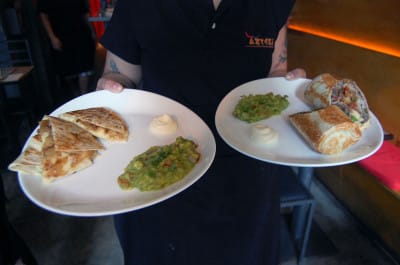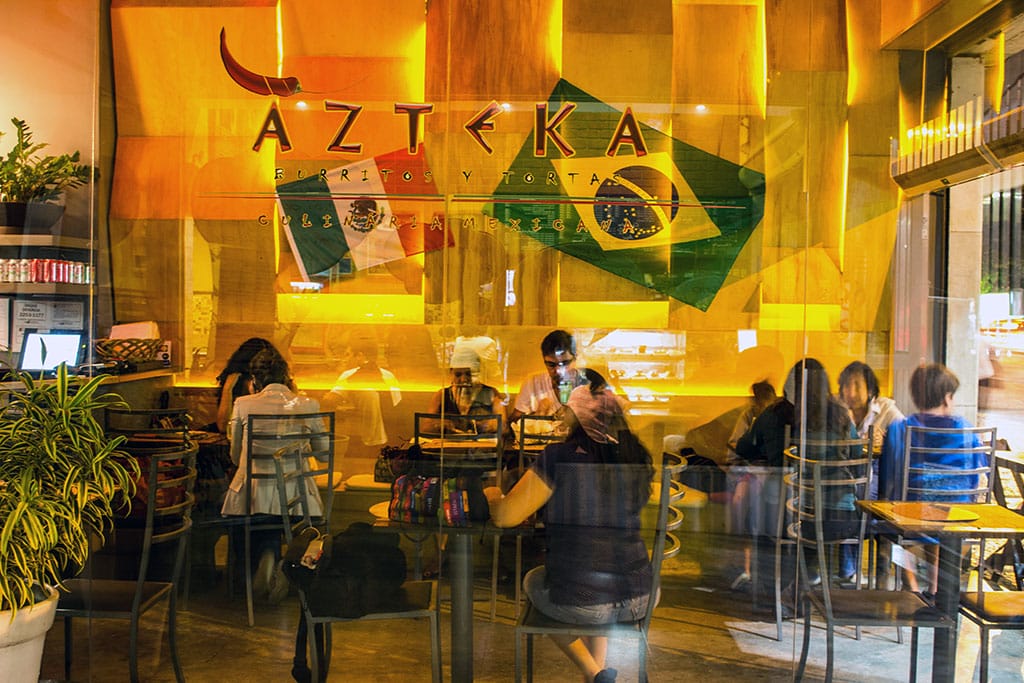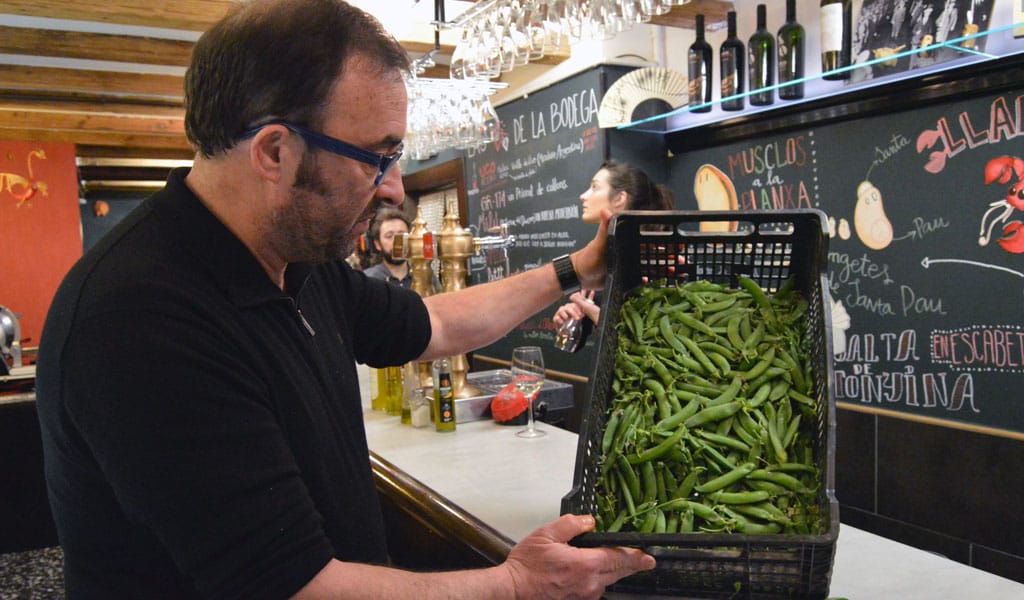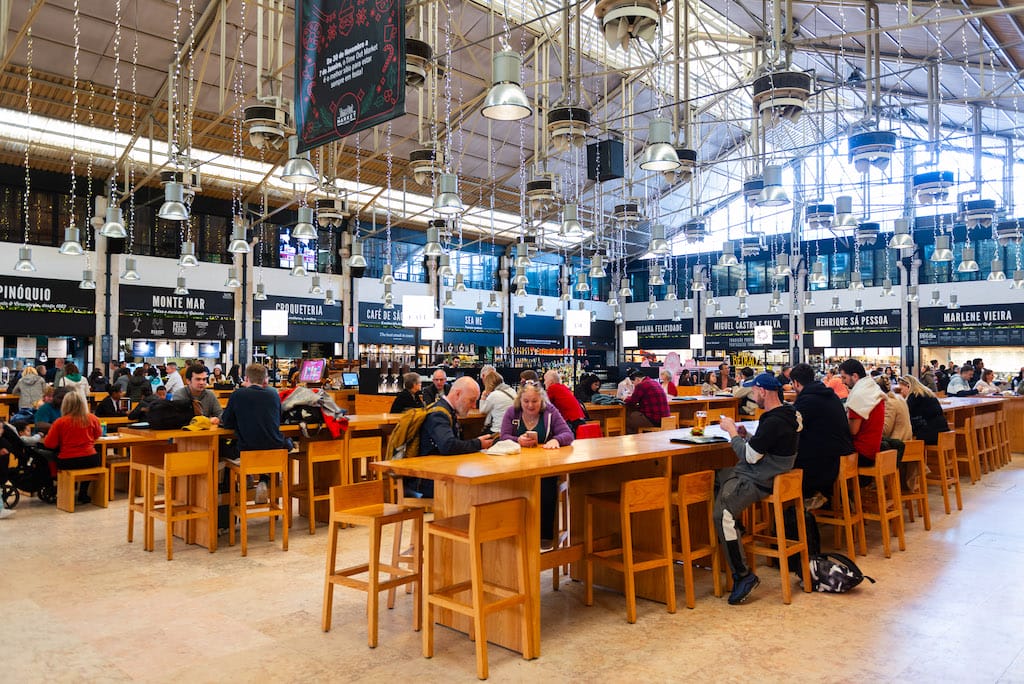Update: This spot is sadly no longer open.
Geography-challenged foreigners often come to Brazil with a vague, ill-informed hope of finding good Mexican food. In Rio, that only happens at Ipanema’s Azteka. In fact, there are few restaurants we find as compelling in the touristy beachside neighborhood as this one, focusing on Tex-Mex cuisine adapted slightly for Brazilian palates.
The breadbox-sized eatery was established by Miguel F. Campos and his Bulgarian wife, Aglika Angelova, a professional piano teacher, after the couple scouted out a new country in which to start a new chapter of their lives together. The two met at an organic pizzeria in Chicago. Campos, who hails from Acapulco, had lived in the U.S. since he was 17 and had honed his culinary prowess in eateries across Illinois and California. By the time he was 35, they were tired of the cold and wanted out of the U.S.
It was 2011, and Brazil was having its boom moment. The picture was one of a countrywide crescendo, as the government spent lavishly on World Cup stadiums and Summer Olympics infrastructure. Investor visas like the one Miguel got came at a relatively affordable price: 150,000 reais, or about $80,500 at the time. Sadly, that boom moment has since turned into a deep nosedive, with Brazil poised to enter its second year of an economic recession. Public spending on Olympic infrastructure goes forward as outsize World Cup venues struggle to find events to host and employees of public clinics and universities wake up to find that their paychecks just don’t come. The real has lost more than half its value against the dollar since Campos and Angelova moved here. Still, the couple says they are making Rio their home, and carioca culture and weather feel relatable to Campos.
Azteka sits half a block from Ipanema’s central Praça General Osório and just a block from where a new metro line is being constructed; on the skyline is the towering elevator to the Cantagalo favela, which brings families up to the steep, self-made settlement above this most iconic neighborhood of Rio. Both projects are a reminder of the soaring optimism of a new Rio that brought gringos flocking here as the economies of rich countries bottomed out after the 2008 financial crisis. Rents in Ipanema soared to prices seen in New York and Paris, and foreign tastes like Nespresso coffee and Delirium Tremens beer cropped up in the neighborhood. Rio was a city constantly pulling new tricks out of its sleeve: here, a cable car in a favela, there, an electrical station-turned leisure and skate park in a blue-collar suburb. With one lavish mega sporting event over and one more to go in 2016, the beachside city has traded its El Dorado dreaminess for a waiting-for-the-dust-to-settle disquiet.
Thankfully for Campos and Angelova, their bet has been a solid success, quality Tex-Mex with contemporary sensibilities having found their rightful place in this city’s fabric. They stick to familiar formats – tacos, burritos, quesadillas and small plates – and emphasize organic ingredients when available, which means going heavy on vegetables and natural toppings like freshly chopped pico de gallo and green tomatillo sauce. By American Tex-Mex standards, Azteka’s owners would be considered almost averse to oil and frying, preferring a grill and just enough cheese to add a savory finish to the dishes.
 The basics here hit the spot, like a serving of guacamole with a basket of tortilla chips – which are surprisingly hard to come by in junk food-loving Rio. A satisfyingly buttery sour cream pairs richly with the grilled pineapple quesadilla, the latter hitting a particularly strong note on the Brazilian sweet-and-savory palate. An eggplant burrito may sound deviant to a Tex-Mex loyalist, but it comes out nicely chewy and flavorful in Campos’s kitchen. Some things are crowd pleasers across the board: Brazilian and Tex-Mex cuisines are both liberal in their use of chorizo and pork shanks, mainstays on Azteka’s menu.
The basics here hit the spot, like a serving of guacamole with a basket of tortilla chips – which are surprisingly hard to come by in junk food-loving Rio. A satisfyingly buttery sour cream pairs richly with the grilled pineapple quesadilla, the latter hitting a particularly strong note on the Brazilian sweet-and-savory palate. An eggplant burrito may sound deviant to a Tex-Mex loyalist, but it comes out nicely chewy and flavorful in Campos’s kitchen. Some things are crowd pleasers across the board: Brazilian and Tex-Mex cuisines are both liberal in their use of chorizo and pork shanks, mainstays on Azteka’s menu.
Some people warned the couple that Brazilians would avoid spiciness, so Campos makes that part optional. But spice there is for those who seek it – peppery salsas and, when he can obtain it, the complex flavors of a shredded chicken burrito topped with smooth and chocolatey mole poblano. Sourcing ingredients requires ingenuity: when Azteka first opened, Campos’s mom sent him chipotle peppers through the mail from Mexico, and his tortillas came from Texas. Campos brought back 4 kilos of mole poblano himself on his last trip north.
Detail-oriented Campos frets over his ingredients, but we think the results are solid. “We want to offer a bit of our Mexican traditions and culture, but as you know, here it’s complicated,” he said. He worries over the flavor of avocados here – Brazilian abacates have the same quantity of flavor as their fist-sized peers in North America, but spread out over a fruit the size of an American football.
Campos notes that cariocas tend to make the rounds of the new Tex-Mex options in the city – where staff are wont to wear kitschy sombreros and put flowers in their hair – but just seem to keep coming back to the small and tasty Azteka.
(top photo by Vinicius Camiza; above photo by Taylor Barnes)
 April 21, 2017 Spring in Barcelona
April 21, 2017 Spring in Barcelona
Barcelona’s urban sprawl makes it easy to forget that the city is adjacent to two […] Posted in Barcelona February 1, 2024 Market Watch
February 1, 2024 Market Watch
It’s not an exaggeration to say that Lisbon’s fresh markets are disappearing. The […] Posted in Lisbon March 11, 2022 Nanjing Soup Dumpling
March 11, 2022 Nanjing Soup Dumpling
Any Shanghai denizen who has lived in the city for longer than a few months worships at […] Posted in Shanghai
Published on March 10, 2016
Related stories
April 21, 2017
BarcelonaBarcelona’s urban sprawl makes it easy to forget that the city is adjacent to two fertile regions to the north and south, El Maresme and El Baix Llobregat, which provide numerous hyperlocal culinary treasures throughout the year. In spring as in other seasons, these treasures appear at markets and restaurants, their origins proudly displayed, sometimes…
February 1, 2024
LisbonIt’s not an exaggeration to say that Lisbon’s fresh markets are disappearing. The Greater Lisbon area is home to 28 market spaces, yet only ten of these witness any significant commercial activity. As the city’s shoppers increasingly shift to supermarkets, its traditional markets have had to find new ways to remain relevant. In an effort…
March 11, 2022
ShanghaiAny Shanghai denizen who has lived in the city for longer than a few months worships at the altar of xiǎolóngbāo (小笼包). These steamed buns of goodness – tiny pork dumplings with a slurp of soup wrapped up in a wonton wrapper – provide delicious fodder for debates among Shanghai’s fiercest foodies. We all have…


















































































